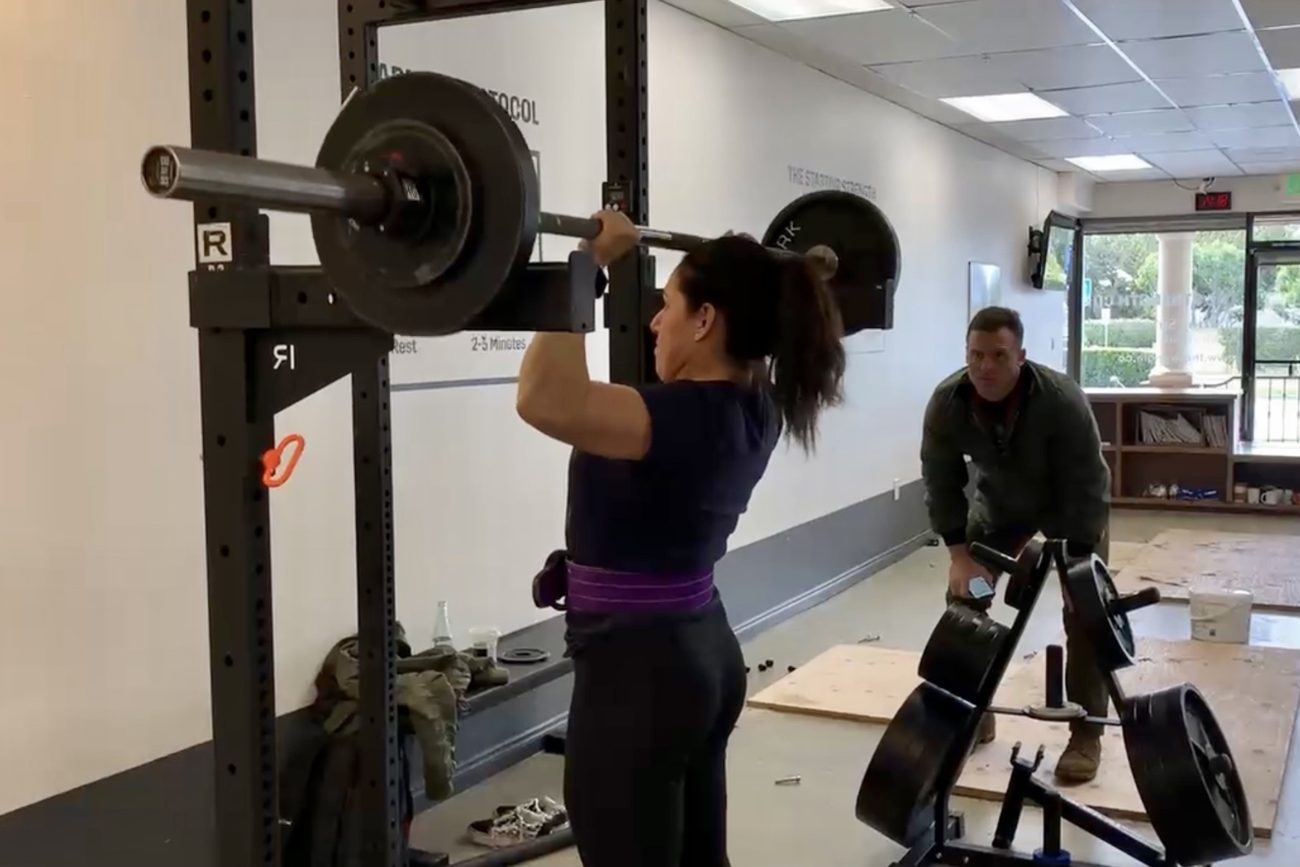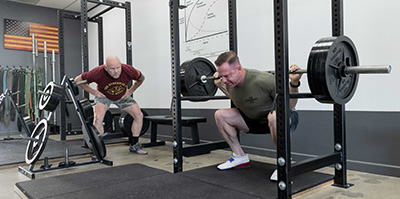Progressing Your Press
By Grant Broggi, SSC
“I HATE THE PRESS”
Believe it or not we hear some of our lifters say this from time to time in our gyms. No they’re not yelling at their barbell about the media, they’re frustrated because they just attempted a rep and missed it.
Kidding aside the press can be demoralizing. It’s a very difficult exercise and it can take a lifter years to achieve a bodyweight press (which is no small feat). This does not mean to give up, it means you need to have an intelligent approach on progress.
Roz, one of my online lifters, is an athletic individual who is a great lifter even though she first touched a barbell 4 months ago. She never misses a workout and does exactly what her coach tells her to do.
So when her press started to stall instead of allowing her to fail and get stuck, we changed our approach and even made some changes to her technique. It has worked, and she is still adding weight to the bar each session.
So today I thought I would share some overall thoughts on the press, why it is different than the bigger lifts and some strategies to keep you from yelling at your barbell.
Why Press?
It’s an ultimate tester of both physical and mental strength. Can you lift something heavy over your head? When the bar seems to come to a complete stop can you stay focused to keep driving it?
It’s also a great strength developer of the shoulders, triceps, traps and even abs. But you already know these things and that’s why you’re frustrated. You want your press to have numbers like your squat, bench press (yes we do that too), and deadlift.
You need to press and you need to bench press, and just because they progress slower than your squat and deadlift is not a reason for you to be frustrated.
“I’m So Weak”
One of the reasons we see lifters get frustrated with their presses is because they think that they are not good at it. When they look at their press numbers compared to their squat and deadlifts it seems… low. That’s because it is, and that’s okay.
Here’s the difference, the squat and deadlift use the most muscle mass of the big four lifts. Since more of your body is involved you can make rapid progress as a new lifter, and even begin to look and feel “strong” within a matter of weeks. Your leg muscles and posterior chain start to look lean and muscular; your traps and lats start to look like what you wanted them to. You begin to look fit, like a person who works out. This is true for both women and men.
But the press and the bench press respond a bit differently. With the bench press, you at least get to lie down, and the bench supports some of the weight. In the press, it’s all you. Just you and the barbell. It uses less muscle mass and has a long way to go. It by nature has a lower number. But you can make that number bigger.
Learning how to do it correctly from day one, and then progressing smartly can make all the difference. Here’s our process.
“STRICT” Form

When we teach someone to press for the very first time, we almost always start by teaching them the “strict” press. This was the case with Roz. With any new lifter we want them to be successful, so we start with the basics and keep the movement simple.
So what did day one look like for Roz? She walked out with the bar, assumed her squat stance, and pressed the bar overhead keeping it close to her body. Boom. First presses in the bag.
Most women that come into the gym begin pressing with either the 15lbs or 33lbs bar, most men are able to do the 45lbs bar day one. We generally see that women have less upper body strength than men when they get started. THAT’S OKAY. A simple approach to building your press can help everyone. You just have to do it.
Progression

Once the lifter has nailed down the strict press we begin “micro-loading” it very early. Failed reps for new lifters (first month) should not be happening. If you are failing your press in your first few weeks of training you are taking too big of jumps. You can add 5 to 10lbs to your squat and deadlift for months, the press needs to be micro loaded.
For Roz we started with 2.5lbs jumps for about 4 sessions, and then quickly we go to 2lbs then 1.5lbs, and now to 1lbs. For men we start with 5lbs and then quickly get to 2.5lbs. Failing early is missing out on strength adaptations that are there for the taking. Don’t be greedy, make the small jumps and drive adaptation.
Press 2.0
Once we see our lifters getting closer to failing with the strict press we start to modify the technique. When Roz’s press began to get sticky I taught her Starting Strength’s Press 2.0 method which uses hip movement at the bottom and allows you to use more weight. Once Roz began the hip movement her press kept going up.
So what just happened? Instead of resetting her or allowing her to be upset about a missed rep, we modified the technique so that she can keep getting stronger. This is why coaches with lots of experience are valuable for your progress. They’ve seen these issues before and fixed them lots of time.
The Press 2.0 usually allows progress for a few more weeks, maybe months, maybe forever. There are lots of people that keep this technique their entire lifting careers. For others we move into a layback press, but before we talk about that lets talk reps.
Something About Reps
Remember, when you lift weights the goal is to lift more than you did last time. If we can increase the load on the bar, even if it’s as small as 1.5lbs then that’s what we do. Because 1.5lbs means your 1.5 more pounds stronger than you were last time. That’s progress. But, from time to time adjustments to the amount of repetitions must be made.
Adjustment usually need to be made for women sooner than men. I could go into lots of details on this but let’s keep it simple. We move women to 3s after the first failure and continue to go up in weight. For men we have them retry a weight that they missed a few times and then add a “top set” (new weight) and some “back offs” (3-5% reduction) and keep going.
When most people fail a press they say their “stuck”. You’re not stuck. You missed a rep. Was the form correct? Was it close to your body? Were you tired? There are lots of variables.
The answer is rarely a “reset”. You are most likely not “stuck”. You probably need to train the press MORE AND WITH MORE WEIGHT.
But as far as reps go, use them as your tool, to allow you to put more weight on the bar. If you were doing a weight for three sets of five and missed, go up and do four sets of four, or five sets of three. Lots of options. Again, this where coaching pays press dividends.
The Pin Press and Lay Back Press

A final tool that is useful for lifters is what we call the “Lay Back Press” or “Olympic Press”. I rarely teach this to men because most are not very good at doing it, and if they are they find a way to do it naturally. But I do use this for female lifters all the time, I just taught it to Roz last week.
The press can be particularly frustrating for females. The weight seems so low and their often staring at a 45lbs bar with micro plates on either end. While it doesn’t seem like much, you have to remember that you probably started with the technique bar and are now using the Olympic bar. I know it’s not as exciting as deadlifting 200lbs, but with consistency you will master it.
When Roz’s Press 2.0 started to stall I once again made a technique change and taught her to the pin press. The pin press starts the bar at the forehead and trains the lockout portion of the lift (like a rack pull but for presses). Because it is a shorter range of motion it allows more weight on the bar than a regular press — this not only strengthens the “sticky” part of the lift and lockout, but it also is very encouraging to the lifter. Because the numbers keep going up.
Look, I’m a lifter like you. I get it, the numbers are the fun part of this. Not the movements. From my mother, to the powerlifting competitor to our clients in their 80s. Everyone wants to see the numbers go up.
So the pin press allows just that — the numbers to continue to rise. After a few sessions of the pin press I noticed that Roz was a good candidate for the layback press. The layback press simply ads the hips a second time into the movement. There’s lots of reasons as to why this is effective, but what you need to understand is that it’s another tool for you to keep progress going.
Patience
View this post on Instagram
The Press is hard. We’re aware. But you can continue to have progress with the correct approach. One thing I will say about Roz is that she has been very patient over the last 4 months. And her patience has paid off big time. We were recently chatting about her press and she had this to say:
“The hip thrust and then the lean back thing have both totally blown my mind because initially with the hip thrust I felt as though there was absolutely no way I could go up in weight, and then I did! And then the lean back, again I went up and continue to go up!
The best bit about strength training with you is that the focus is totally not on my weight and what I look like, it’s about getting under the bar, form and getting stronger! But what I look like has changed so drastically that it cannot be ignored!”
Roz is going to keep getting stronger. And you can too. Hard work, showing up, and patience lead to success under the bar. A qualified barbell coach can also help you get there.


